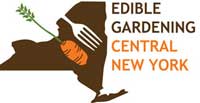| Edible Gardening CNY |  |
Sun., May 12, 2:00 pm at Liverpool Library TOPIC: Preserving your harvest, presented by John Allen and Hope Kuniholm Free and open to the public Learn more about edible gardening in CNY
|
Plantasia at Baltimore Woods
Sat., May 18,
8 am - 2 pm
(Members only - Fri., May 17, 4 pm - 7 pm)
|
 | | Goldenrod |
|
Available at the member's only event on Friday are free chestnut tree seeds ready for planting. Native plants, food, regional vendors and more! For more information, call 673-1350 or visit the website for more details.
|
| Our Habitat Garden |  |
Visit Our Habitat Garden website for information on providing habitat, earth-friendly gardening practices, plants, and various creatures here in Central New York.
|
HGCNY Officers
| |
| President:
Janet Allen
Vice-President:
Carol Biesemeyer
Treasurer:
Randi Starmer
Secretary:
Soule Leiter
Membership:
Linda Rossiter
Program Chair:
Carol Biesemeyer
Newsletter Editor:
Janet Allen
Additional Planning Committee Members:
Beth Mitchell
Dave Mitchell
John Allen
Peter Huntington
|
| HGCNY on Facebook |
As as more of us participate on our Facebook page, this will become a useful resource for asking (and answering!) local HGCNYers' questions about habitat gardening. |
|
Join HGCNY!
|  |
Becoming an official member of HGCNY is easy: just join Wild Ones! Basic household membership is $37/year, but there are other options, too. (See membership application or website.)
Wild Ones
P.O. Box 1274
Appleton, Wisconsin 54912-1274
Make checks payable to Wild Ones.
Or telephone toll-free 877-394-9453.
|
|
Our Edible Garden
|  | Visit OurEdibleGarden.org to see an example of a Central New York edible garden, the perfect companion to your habitat garden.
|
| Interested in Edible Gardening? | 
|
If you'd like to get information on Edible Gardening CNY, just email John to find out about edible gardening tours and monthly programs. Free and open to the public! |
|
Greetings!
 | | Note wing remnants of this robin's meal! |
What a wonderful year of programs! We indeed have a wealth of knowledge in CNY. We're looking forward to next year's programs starting in September. Thank you to all of our presenters, our attendees, and especially to all the HGCNY Helpers who make it all possible. And, of course, we especially thank Liverpool Public Library for their support and their excellent facilities! Summer Show Me Help Me Tours
In the summer, we look forward to visiting habitat gardens, large and small, urban and suburban. We'll be announcing the dates and locations in future newsletters. Your habitat garden? Have you been working on creating your habitat garden with native plants? If you'd like to share what you've done and perhaps have some of your questions answered, contact me. We'll plan our summer garden tour schedule in June.
Other programs
I'll be giving presentations at the following times and locations:
Wed. May 22 at 6:30 Habitat Gardening for Life Northern Onondaga Public Library in Cicero.
Thurs. June 13 at 7:00 pm Creating a Monarch Waystation Dewitt Community Library
Both are free and open to the public.
Janet Allen President, HGCNY |
|
|
Featured plant: Common bluestar
 | Common bluestar
(Amsonia tabernaemontana) |
Common bluestar (Amsonia tabernaemontana) is aptly named.
It's fairly tall - about 36-40 inches - and long-lived.
It's not very fussy in its requirements. It will grow in dry to moist soil in sun to shade. As with many plants, if it's in sun, it will appreciate a little more moisture than if it's growing in the shade.
It blooms fairly early (already blooming in my garden!), and thus, it's a favorite nectar source for mourning cloak butterflies and other early butterflies. (Mourning cloaks overwinter as adults, so when spring comes, nectar sources are welcome.)
As William Cullina says, "Their long season of interest makes bluestars invaluable in the perennial border, wild garden, and wildlife garden."
|
|
Use vegetation to increase energy efficiency
 | | This red maple makes our south-side porch liveable in the summer |
Landscape for Life is a project of the Lady Bird Johnson Wildflower Center and the US Botanic Garden. It provides a wealth of information about sustainable landscapes, including how landscaping can reduce energy use.
To reduce A/C energy use in summer, they recommend that we in our temperate region:
* Shade A/C units, which can increase their efficiency by as much as 10%.
* Shade all windows that receive direct sunlight.
* Shade east- and west-facing walls and the roof.
* Shade heat sinks such as dark-colored driveways, roadways, or patios, which absorb and radiate significant amounts of heat into surrounding materials and air masses. This warm air affects the inside temperature of the home and the comfort level of people in the landscape.
Using vegetation to provide shade
In our temperate region, we want to block solar heat in the summer but let it in during the winter. Deciduous vines, trees, and shrubs can keep your home and landscape cool in the summer and reduce energy needs in the winter.
Creating a neighborhood plan, especially where yards are small, is optimal since often the best place to site a tree to shade your house is your neighbor's yard and vice versa!
|
Excellent (and FREE) videos online
 | | The 'glorious and unappreciated material beneath our feet' |
Fascinating, top-notch videos are available!
Monarch Butterflies Migration Google Earth Tour (Published 4/26/13) - A story about the migration of the eastern population of monarch butterflies in North America, and the people that help them out along the way. Produced by Atlantic Public Media in cooperation with the Encyclopedia of Life Learning + Education group located at the Harvard Museum of Comparative Zoology. (12 min)
Dirt! The Movie - An insightful and timely film that tells the story of the glorious and unappreciated material beneath our feet. Inspired by William Bryant Logan's acclaimed book Dirt: The Ecstatic Skin of the Earth, Dirt! The Movie takes a humorous and substantial look into the history and current state of the living organic matter that we come from and will later return to. (From the trailer ...) (1 Hr 18 min.) |
|
The pollinator refugees
 | | Bumblebee on a joe-pye |
[I]t is the gardeners of the world who can open their gardens to the pollinator refugees, who can provide temporary or permanent shelter until humans refine our outlook on the natural world.
By actively sheltering pollinators, we gardeners remind ourselves that we have the power to positively overcome some of humankind's more destructive tendencies. Additionally, our gardens provide a teaching laboratory for young children to connect with an ever-vanishing natural environment.
Our gardens might provide a network of urban and suburban biological corridors that link more protected sites and allow pollinators to move freely from one natural area via our gardens to other natural areas.
And finally, all lofty, Earth-saving notions aside, you might wish to encourage pollinators in your gardens simply because they are more interesting than any television show you can imagine.
~ Eric Grissell,
Insects and Gardens: In Pursuit of a Garden Ecology
|
|
|
|
|